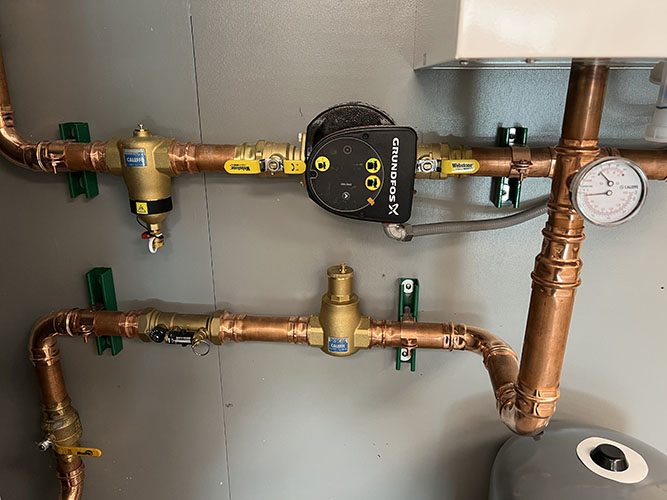Let’s Get Serious About Air Separation
Tips, tricks and ideas for hydronic technicians and designers.

We’ve all had that one job — the job plagued with noise, airlocked zones, no heat calls and unhappy customers. So unhappy that hearing their name sends shivers up your spine.
Maybe you’re thinking of a job that’s not quite that bad. Instead, the customer is so well-trained he can bleed radiators like it’s his job. In either case, on top of being a nuisance, air in hydronic systems will impact efficiency and encourage corrosion. With the right designs, best practices and due diligence, we can put an end to it.
The first question we must ask ourselves is, “Where is the air coming from?” The answer is simple if you’re installing a new system or refilling an older one after a repair. The system is full of air and now you’re filling it with water. Even with a good purge, the fresh water is still full of dissolved gases. This is where we rely on air vents and a good air separator (Figure 1) to do its job and remove all that air.
On the other hand, what if you have a system continually haunted by air issues? The house is decades old; it shouldn’t have these air problems, right? Sound like a good application for an air separator? Don’t get me wrong, I’ll always recommend a good air separator but, in this case, we need to take a step back. Where is the air coming from? You’ve purged this house several times and it keeps coming back!
You should consider a few less-than-obvious places while figuring out your problem. The first is your air vents (Figure 2). These devices, by design, are supposed to vent air but, in the right circumstances, they can let air in. This is because air vents require a positive system pressure in both static and dynamic conditions to do their intended job.
The most common reason for a possible negative pressure at an air vent is less than adequate static pressure (0.433 psi/foot of system height + 5 psi), but could also be due to improper circulator sizing and restrictions in piping.
The next possibility to investigate is makeup water. Is the system fill valve always adding fresh water without your knowledge? In my area, it was not uncommon for radiant applications to use soft copper in poured concrete or plaster ceilings. In most cases, these systems are 60-plus years old; the concrete will inevitably chew its way through the copper.
Hidden leaks such as this will bring loads of fresh water into your system — fresh water full of dissolved oxygen. If this is one of your concerns, try valving off the fill valve to see if the pressure drops over time. Another option is to add a water meter to the line connected to your fill valve. Once confirmed, the search is on, and a good infrared camera will pay for itself quickly.
The last consideration is piping or materials without an oxygen barrier. It may have seemed like a good idea at the time for a budget-conscious do-it-yourselfer, but that potable PEX he buried in concrete will return to haunt him. In closed hydronic systems, you’ll find that oxygen is taken out of the equation by either an air removal device or the corrosion process.
PEX without an oxygen barrier allows oxygen to continually permeate its walls at a much higher rate than PEX with an oxygen barrier. This leads to nuisance air issues and continual corrosion. This type of system typically requires removal of any ferrous materials or a chemical treatment regimen that will quickly eat up any savings from not using an appropriate PEX with an oxygen barrier.
Make your Job Easier
After getting to the bottom of your actual problem, there are a few more things to make your job a lot easier. The first is properly sizing the piping in your distribution system. Ensuring velocities between 2-to-4 feet per second will help to keep air entrained and give it a better chance of finding its way back to your central air separator.
Velocity is also the reason that air separators are much larger in diameter than the pipe they’re connected to. Unlike your distribution piping, this large diameter reduces the velocity and allows the air bubbles a chance to collect and see their way out through the air vent on top.
My next suggestion has to do with temperature. As temperatures increase, air is less soluble in water. So, once the system is filled up, get it hot! What if you’re starting the system in September, and your outdoor reset controls are only calling for 87 F supply water temperature? Find a way to temporarily disable these controls and get the water as warm as you can. Be careful not to overheat the imported flooring made of elephant toenail clippings!
This early heating of the system affords the air separator an early opportunity to remove air from the system and, more importantly, prevent callbacks.
The last thing to check off your list is the proper location of your circulator, air separator and expansion tank. As your circulator imparts energy into the system fluid, you’ll notice a difference in pressure between the inlet and outlet.
Just as you must pump away from your expansion tank, the same rule applies to your air separator (Figure 3). Being on the suction side of the circulator with lower pressure, your air separator has a better chance of catching those pesky air bubbles as air is also less soluble as pressure decreases.
As we try to increase comfort and efficiency for our customers, remember that air elimination needs to be at the top of your list. Understanding and implementing best practices will result in trouble-free and efficient hydronic systems. Side effects may include happy customers who can finally retire their bleeder key! l
Cody Mack has nearly 20 years’ experience as an installation contractor, service technician, application engineer and, most recently, as training manager for Caleffi North America. He’s a family man, gear-head, and motorcycle enthusiast with a common-sense approach to hydronics. Cody can be reached at cody.mack@caleffi.com.





